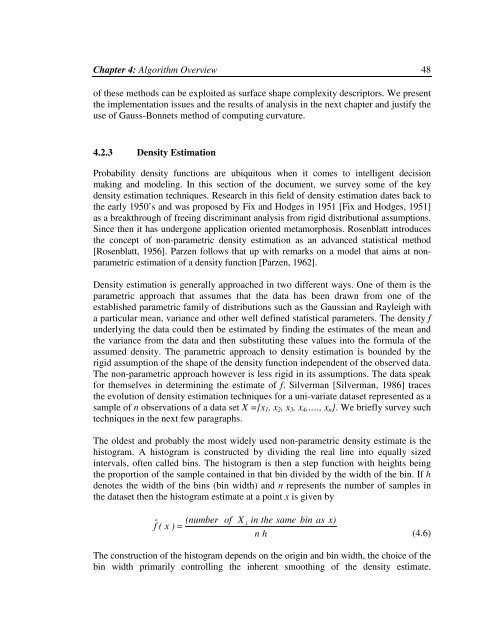To the Graduate Council: I am submitting herewith a thesis written by ...
To the Graduate Council: I am submitting herewith a thesis written by ...
To the Graduate Council: I am submitting herewith a thesis written by ...
You also want an ePaper? Increase the reach of your titles
YUMPU automatically turns print PDFs into web optimized ePapers that Google loves.
Chapter 4: Algorithm Overview 48of <strong>the</strong>se methods can be exploited as surface shape complexity descriptors. We present<strong>the</strong> implementation issues and <strong>the</strong> results of analysis in <strong>the</strong> next chapter and justify <strong>the</strong>use of Gauss-Bonnets method of computing curvature.4.2.3 Density EstimationProbability density functions are ubiquitous when it comes to intelligent decisionmaking and modeling. In this section of <strong>the</strong> document, we survey some of <strong>the</strong> keydensity estimation techniques. Research in this field of density estimation dates back to<strong>the</strong> early 1950’s and was proposed <strong>by</strong> Fix and Hodges in 1951 [Fix and Hodges, 1951]as a breakthrough of freeing discriminant analysis from rigid distributional assumptions.Since <strong>the</strong>n it has undergone application oriented met<strong>am</strong>orphosis. Rosenblatt introduces<strong>the</strong> concept of non-par<strong>am</strong>etric density estimation as an advanced statistical method[Rosenblatt, 1956]. Parzen follows that up with remarks on a model that aims at nonpar<strong>am</strong>etricestimation of a density function [Parzen, 1962].Density estimation is generally approached in two different ways. One of <strong>the</strong>m is <strong>the</strong>par<strong>am</strong>etric approach that assumes that <strong>the</strong> data has been drawn from one of <strong>the</strong>established par<strong>am</strong>etric f<strong>am</strong>ily of distributions such as <strong>the</strong> Gaussian and Rayleigh witha particular mean, variance and o<strong>the</strong>r well defined statistical par<strong>am</strong>eters. The density funderlying <strong>the</strong> data could <strong>the</strong>n be estimated <strong>by</strong> finding <strong>the</strong> estimates of <strong>the</strong> mean and<strong>the</strong> variance from <strong>the</strong> data and <strong>the</strong>n substituting <strong>the</strong>se values into <strong>the</strong> formula of <strong>the</strong>assumed density. The par<strong>am</strong>etric approach to density estimation is bounded <strong>by</strong> <strong>the</strong>rigid assumption of <strong>the</strong> shape of <strong>the</strong> density function independent of <strong>the</strong> observed data.The non-par<strong>am</strong>etric approach however is less rigid in its assumptions. The data speakfor <strong>the</strong>mselves in determining <strong>the</strong> estimate of f. Silverman [Silverman, 1986] traces<strong>the</strong> evolution of density estimation techniques for a uni-variate dataset represented as as<strong>am</strong>ple of n observations of a data set X ={x 1 , x 2 , x 3 , x 4 ,…., x n }. We briefly survey suchtechniques in <strong>the</strong> next few paragraphs.The oldest and probably <strong>the</strong> most widely used non-par<strong>am</strong>etric density estimate is <strong>the</strong>histogr<strong>am</strong>. A histogr<strong>am</strong> is constructed <strong>by</strong> dividing <strong>the</strong> real line into equally sizedintervals, often called bins. The histogr<strong>am</strong> is <strong>the</strong>n a step function with heights being<strong>the</strong> proportion of <strong>the</strong> s<strong>am</strong>ple contained in that bin divided <strong>by</strong> <strong>the</strong> width of <strong>the</strong> bin. If hdenotes <strong>the</strong> width of <strong>the</strong> bins (bin width) and n represents <strong>the</strong> number of s<strong>am</strong>ples in<strong>the</strong> dataset <strong>the</strong>n <strong>the</strong> histogr<strong>am</strong> estimate at a point x is given <strong>by</strong>fˆ ( x ) =(numberofXiin <strong>the</strong>n hs<strong>am</strong>ebinasx)(4.6)The construction of <strong>the</strong> histogr<strong>am</strong> depends on <strong>the</strong> origin and bin width, <strong>the</strong> choice of <strong>the</strong>bin width primarily controlling <strong>the</strong> inherent smoothing of <strong>the</strong> density estimate.
















